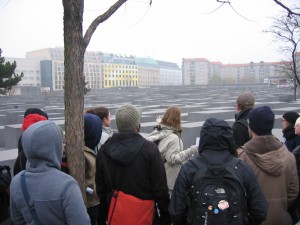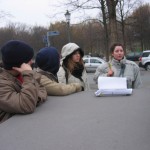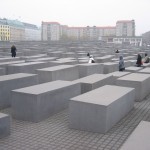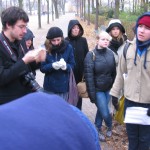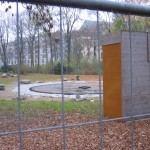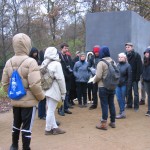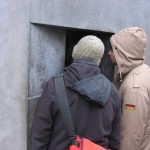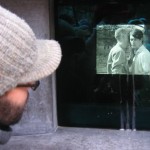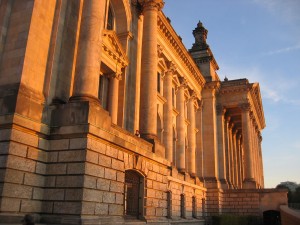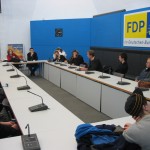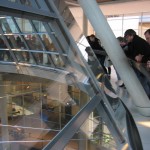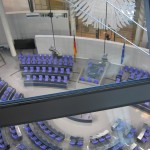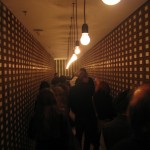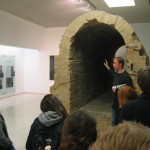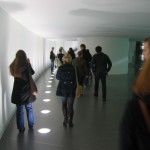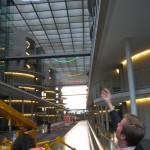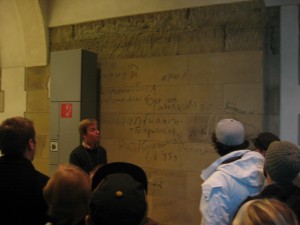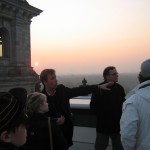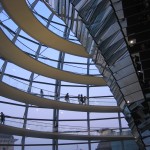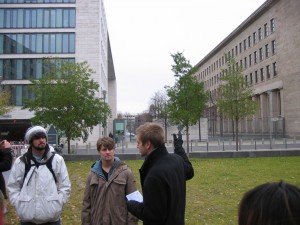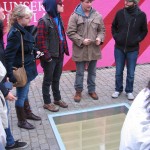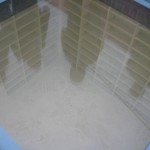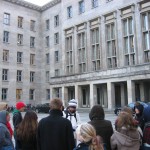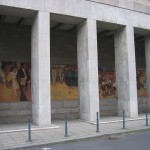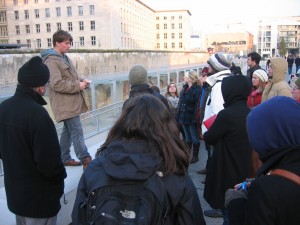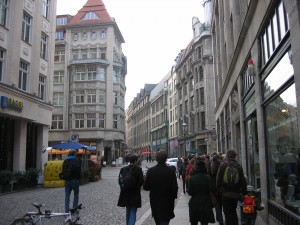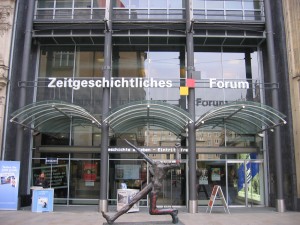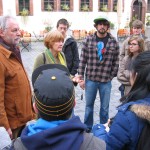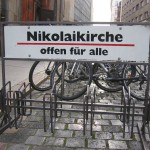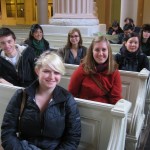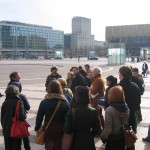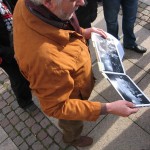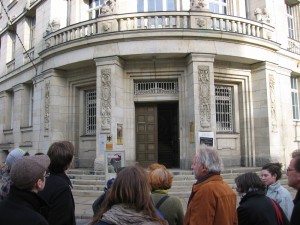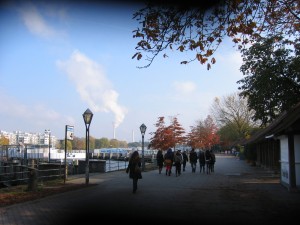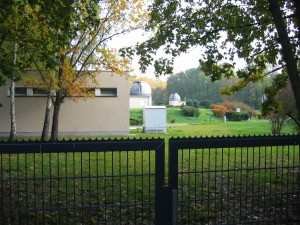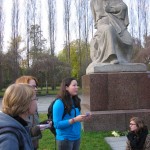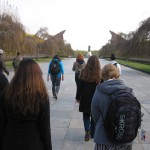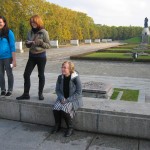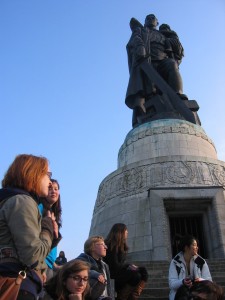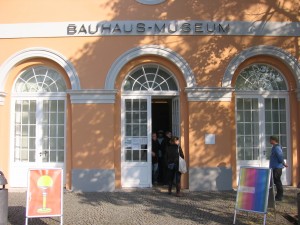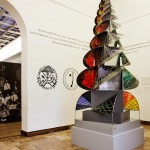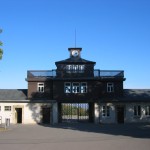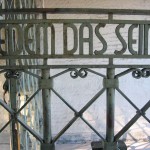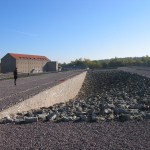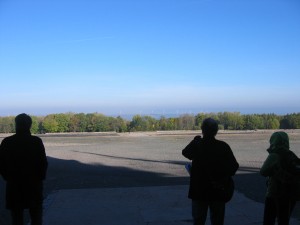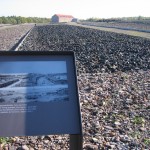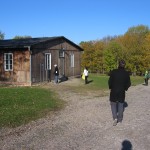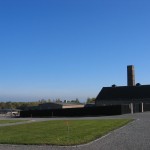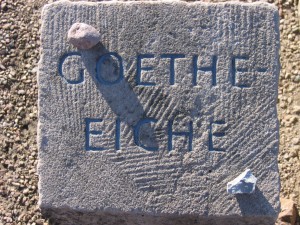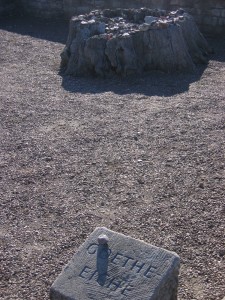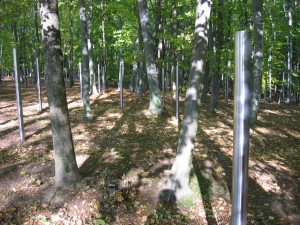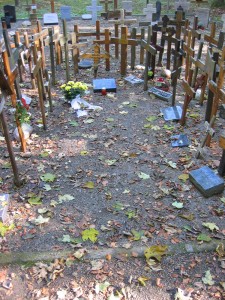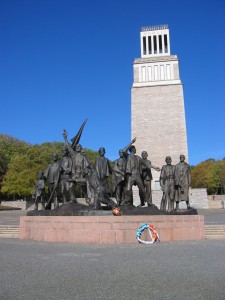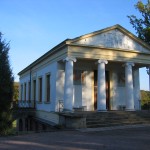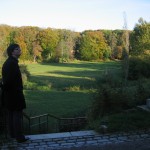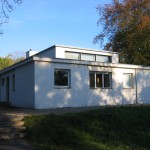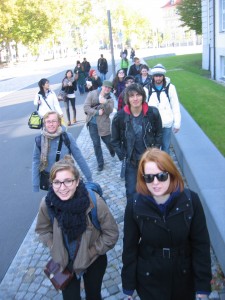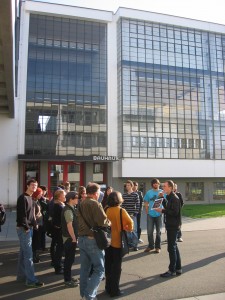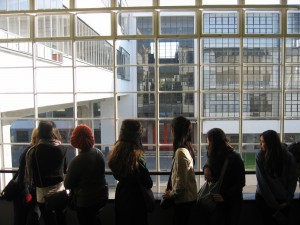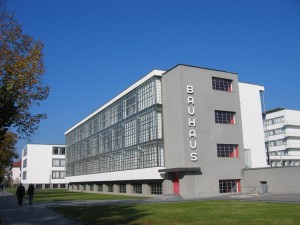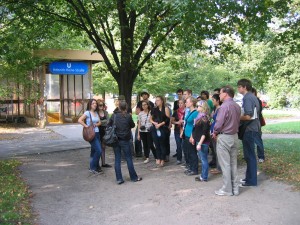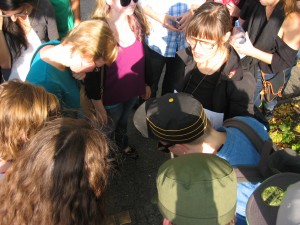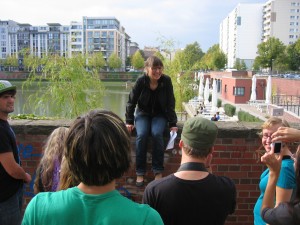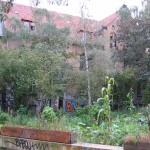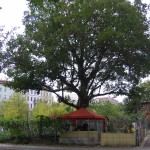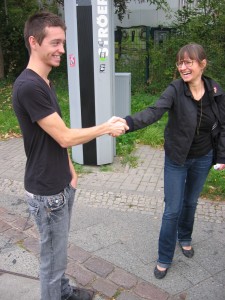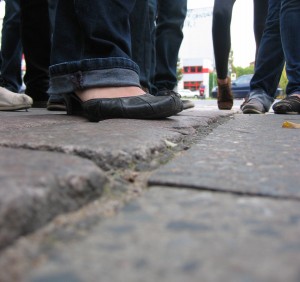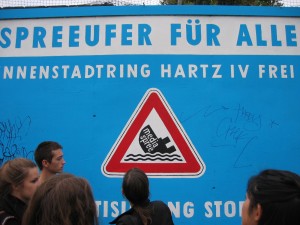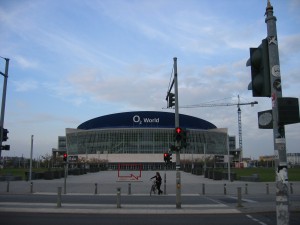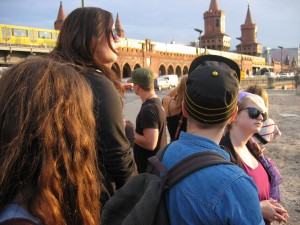A tour of three Holocaust memorials with Ryder, Cassie and Michelle
Our student-led tour this week took us to the Memorial to the Murdered Jews of Europe, a large memorial in the center of Berlin. Our guides Michelle and Cassie explained the history of the site, and encouraged us to experience it for ourselves. The memorial, designed by Peter Eisenman, consists of a field of stelae meant to engender a highly personal experience for each visitor.
Our tour also included a visit to a lesser-known, though still centrally-located, memorial: the Memorial to the Roma and Sinti Murdered by the Nazis. Because of problems with the materials, it’s still unfinished. Ryder introduced us to the history of these groups, as well as some of the controversies surrounding the building of the memorial.
We also stopped to take in the memorial honoring homosexual victims of the Holocaust, and learned a little about gay history in Berlin and Germany. Together, all three of these memorials represent important gestures by the German government toward honoring the victims of the Nazis and ensuring that such a tragedy does not occur here again. We were especially lucky that our students took the time to point out the two lesser-known memorials that augment the powerful Memorial to the Murdered Jews of Europe.
A visit to the Reichstag
Our activities this week included a tour of the Reichstag (the German parliament building).
Our guide was Ulli Finkenbusch, who works for the Free Democratic Party (FDP). After an introductory discussion about some important political issues facing Germany, we took a tour of the building, beginning with the mezzanine level.
On the lower level of the main parliament building, we viewed an artwork by Christian Bolstanski (left), consisting of metal boxes with the names of all the German Parliament members since 1919. We also saw the remains of the tunnel through which the arsonist who set fire to the Reichstag in 1993 is supposed to have entered building.
We then traversed the underground walkway connecting the Reichstag with the parliament meeting rooms and offices in the Paul-Löbe-Haus.
On our way back through the Reichstag, we glimpsed graffiti left by Soviet soldiers in 1945, which has been preserved as part of the integral history of the building.
Our final stop was on the roof, where Ulli pointed out several of the city sights that are visible from there, and we enjoyed a beautiful sunset!
A tour of Nazi architecture in Mitte with Max, Klayton and Nick
Our theme for this week is the rebuilding of Berlin after the fall of the wall, and one of the things that architects, planners and politicians had to contend with was the history of totalitarianism that was still inscribed on the landscape. To deepen our understanding of this issue, our students Nick, Max and Klayton took us on a tour of sites in Mitte with Nazi history today.
The first stop on the tour was the Foreign Ministry, housed in the former Nazi Reichsbank (the browner building to the right). The first freely elected East German parliament also met here for a time in 1989-90, as they negotiated their integration with the West. In the early 1990s, a “Critical Reconstructionist” architect designed an addition (left). This is an approach, used throughout the center of the new Berlin, that seeks to integrate historical building traditions with modern design.
Next, we visited the memorial to the Nazi book burnings on Bebelplatz, right in front of the Humboldt University buildings.
The current Finance Ministry is housed in another interesting building with a layered history. Built to house the Nazi Air Ministry, it then became home to the GDR’s Council of Ministers after 1949. A socialist realist mural (right) was added at this time. The site is also known for its association with the workers’ uprising in 1953, and there is a memorial to this event on the grounds today.
Our last stop on the tour was the Topography of Terror, a site that contains the excavated remains of the Gestapo headquarters, as well as a museum dedicated to the history of Nazi-sponsored persecution. The Berlin Wall also ran along the edge of the site, as you can see above.
We’ll continue our exploration of Berlin’s responses to its own layered past next week, when we’ll be focusing on issues of memorialization.
A trip to Leipzig, epicenter of the Wende
This Friday we took a day trip to Leipzig to learn more about the events that led to the Wende – the momentous “turn” or “change” in 1989 that eventually led to the reunification of Germany.
Our first stop was the Zeitgeschichtliches Forum, a museum that focuses on the the resistance movement that was centered in Leipzig in the 1980s, and its eventual results in the “peaceful revolution.”
Afterwards, historians Dorothee Wierling and Bernd Lindner shared their expertise with us on the streets of Leipzig itself, taking us step-by-step along the route walked by the protesters here in 1989. The resistance movement first centered on the Nikolaikirche, a church where politically-charged “peace prayers” had already been taking place for several years. In 1989, attendance began to soar as people joined the movement to demand change.
As the number of protesters grew week by week, they dared to walk further and further along the “Ring” avenue that encircled the city center. Herr Lindner, who took part in the protests, helped us retrace their steps. (He augmented the experience with photos from a book he helped co-author – right.)
By November of 1989, 70,000 protesters were marching together peacefully through the streets of Leipzig. One of the last sites to be incorporated into their route was the Runde Ecke – the building housing the central offices of the Stasi.
As we approach the anniversary of the fall of the Wall, it’s good to remember that this revolution did not begin in Berlin, but in Leipzig. The capital is often privileged in the narrative of the Wende, but it couldn’t have happened without the courage of the protesters in this other key city.
Treptower Park with Anna, Mariah and Janet
The student tour this week brought us to Treptower Park, home to …
… houseboats (one of three colonies in Berlin) …
An observatory built for a world’s expo in the park around the turn of the century, and later supposedly used by Einstein …
… and an absolutely massive Soviet World War II memorial and cemetery. Since the park lies in what was formerly East Berlin, it was a natural choice for the Soviets to honor 7,000 of their men who died here. The site is now under the official protection and care of the German government, thanks to a line in the treaty signed by the Soviets in 1989.
The main attraction is a 38-foot statue of a Soviet solder saving a child, posed over a broken swastika. Though it’s a bit over the top, one can’t help but think about the staggering number of men buried here. It’s another sobering facet of Berlin’s complex, and often tragic, history.
An afternoon with Mark Curran
Artist and educator Mark Curran spent an afternoon sharing his work with us on Monday. Focused around issues of labor, his photographs, interviews, journals and the resulting installations speak directly to many of the issues we’re wrestling with in our course. He took us through the process of utilizing ethnographic techniques to document and participate in various environments, as well as how he presents his work in a multi-media format. Mark’s work is gripping in its own right, but since I’m asking the class to document their own experience of Berlin using media-based methods informed by ethnography, his talk was very applicable to their work for the course. Several of them expressed how moved, inspired and encouraged they were by his presentation.
Mark’s most recent project centers around the strip mining industry in Cottbus in former East Germany. You can read more about the project here. And here’s a clip showing the installation of the project in a recent exhibition in Portugal:
an installation of EXTRACTS FROM EDEN/AUSSCHNITTE AUS EDEN a project by Mark Curran from Mark Curran on Vimeo.
A trip to Weimar & Dessau
This weekend we traveled to the beautiful city of Weimar, home of Goethe, Schillar, Liszt, and the birthplace of the Bauhaus! Our first stop on Friday afternoon was the Bauhaus museum – a small but unique little space with treasures from the first years of the school’s existence. Unfortunately the Bauhaus school was forced to leave Weimar after the Nazi party gained power in the state of Thüringen in 1924.
This opened a difficult chapter in Weimar’s history, and on Saturday we visited the nearby site of Buchenwald concentration camp.
The most striking thing one finds on entering the camp is the view: the camp is set in the middle of the forest (Buche means “beech” and Wald means “woods”), on a hill that allows a view across the valley. It’s difficult to believe that such horrible things could transpire amidst such natural beauty.
The original barracks are no longer extant – most are now marked with dark loose stones, but one has been rebuilt in its original form. One of the few other buildings still standing on the grounds is the crematorium, which was strangely located adjacent to a little petting zoo built for the children of the SS.
The Goethe Eiche – Goethe’s Oak – was an oak tree left standing in the camp by the SS. The prisoners named it in remembrance of Goethe’s trips to this same forest. It was damaged in an Allied bombing in 1944 and subsequently chopped down.
Buchenwald was also used as a Soviet internment camp after the war. It’s thought that about 7,ooo people died during this time in the camp’s history, and they were buried in unmarked graves in the woods surrounding the site. Because Thüringen became part of East Germany, the deaths were not acknowledged during the Cold War. The fall of the Berlin Wall finally allowed the victims’ families to speak up and publicly remember their relatives.
The Soviets left another highly visible legacy: a huge memorial to the camp’s liberation, on a hill overlooking Weimar. Buchenwald’s many layers of tragic history gave us much to consider …
The class was free to spend the rest of the day exploring the town. Chance and I took a stroll through the park and admired the “Roman House,” the amazing landscape and the first Bauhaus demonstration house, the Haus am Horn.
Today we left Weimar and headed back to Berlin, with a stop in Dessau to visit the most famous site of the Bauhaus, their school building, designed by Walter Gropius and built in 1925-6. We got a fantastic tour from a very knowledgeable and enthusiastic guide, and I think our students might almost be convinced that Modernism isn’t all horrible … (those of us who study architecture are already sold).
We couldn’t have asked for a more lovely day to see this truly seminal piece of architecture. This week we dive into the study of the specter that haunts both the history of the Bauhaus and Buchenwald: the Nazis and their influence on Berlin and Germany.
A walk through our Kiez with Manuela Mangold
Manuela Mangold, a long-time Kreuzberger, gave us a fantastic tour of the students’ “Kiez” in Berlin on Tuesday afternoon. Kiez is a local word meaning “neighborhood,” but it denotes not just a district of the city (in this case, Kreuzberg), but one’s immediate, local surroundings — the place where everyday life is lived.
We started our tour at the Heinrich-Heine-Strasse U-Bahn station, the stop where the students regularly get onto the subway. During the time when Berlin was divided, it was a border crossing used mainly for commercial traffic. Below, the subway station was a “ghost station” — because the wall ran in a zig-zag manner from roughly the southeast to the northwest, trains going from this part of West Berlin would pass under East Berlin on their way to other parts of West Berlin would pass through a completely darkened (and sometimes guarded) station.
Next on our tour was an example of Stolpersteine (“Stumble Stones”), an art project begun in Cologne, but which has left its mark all over Berlin. A form of Holocaust memorial, it marks where victims of the tragedy once lived. People are meant to “stumble” over these on their daily walks, a constant reminder of the importance of remembering the Holocaust, and its impact on life here.
We continued with a look at the path of the Berlin Wall and death strip. Manuela is sitting right between former East and West in the picture! As in most of Berlin, it’s been restored so nicely now that barely a trace of the division remains.
Oppositional culture has been a huge part of Kreuzberg’s identity since the 1970s. Here are two examples of “squatter” culture — both built right up against the Wall. One is a famous house squat, and the other a garden built right in the shadow of the wall, in what was technically East German territory!
We continued along the path of the wall, which is (in some places) marked by a strip of brick set into the ground. (Dominic represented East Germany, shaking hands with a West Berliner!)
Leaving our Kiez and crossing the Spree River, we continued on to talk about the politics of development along the river banks, another area where squatters and other oppositional movements have traditionally made their homes. Now big developers are buying up large swaths of property, driving up rents and bringing a whole new feel to the neighborhood, garnering vehement protest from locals. One glaring example of this is O2 World, a large concert venue whose undeniably corporate aura conflicts tangibly with its surroundings. Its VIP entrance along the river was heavily protested, but got built anyway.
We ended our tour at the Oberbaumbrücke, which was also divided by the Wall. Now, as you can see in the background, the U1 train line can run all the way across it again!
Our Kiez is in some ways the perfect spot for the students, sitting uncomfortably amidst the former East and West, scarred with layers of memory and history – and still transforming before our eyes.
tags
the author
I'm a doctoral student at CUNY Graduate Center. I'm thrilled to be teaching the CHID Berlin program with Prof. John Toews! You can contact me at naraelle [at] gmail.com, or find out more about me at www.naraelle.net.
Blogroll
- Annie Holden's blog
- Cassie Hoeprich's blog
- Dominic Barrera's blog
- Janet Williams's blog
- Mariah Alderete's blog
- Melissa Au's blog
- Robert Hampton's blog
- UW Students Study Abroad Our students Natalie and Cassie are contributing to the official IPE student blog this fall!



